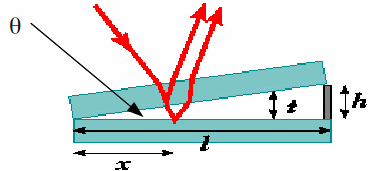If two glass plates are set at a small angle to one another, the gap between them is called an air wedge. For example we could lay microscope slides on top of one another, with a piece of paper between them at one end.

![]()
There is a path difference between rays of light reflected from the top and bottom surfaces of the air wedge. This results in parallel lines of equally spaced constructive and destructive interference fringes.
The path difference due to the air wedge above is 2t. A phase change of![]() occurs at the bottom surface.
occurs at the bottom surface.
The path difference is then![]()
For a bright fringe at the upper surface, the path difference is equal to a whole number of wavelengths:![]()
For a dark fringe at the upper surface, the path difference is equal to a whole number of wavelengths plus half a wavelength:![]()
